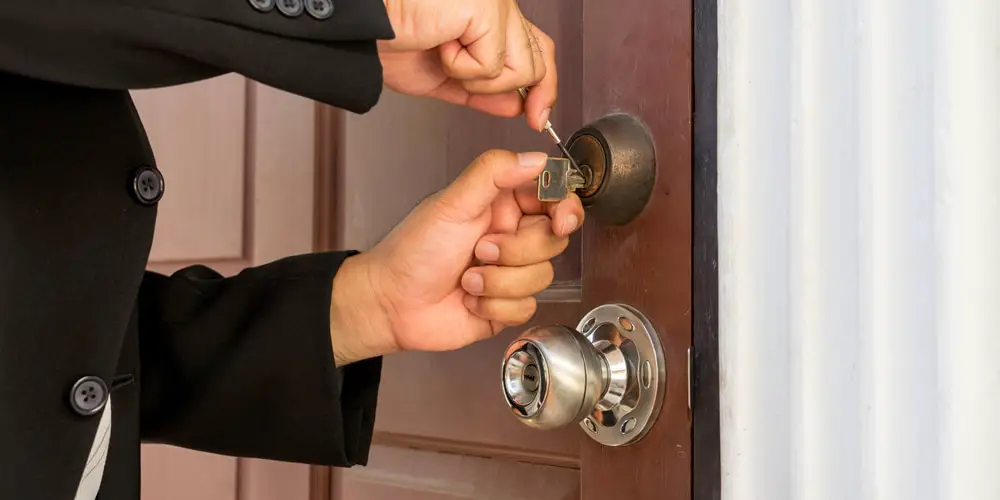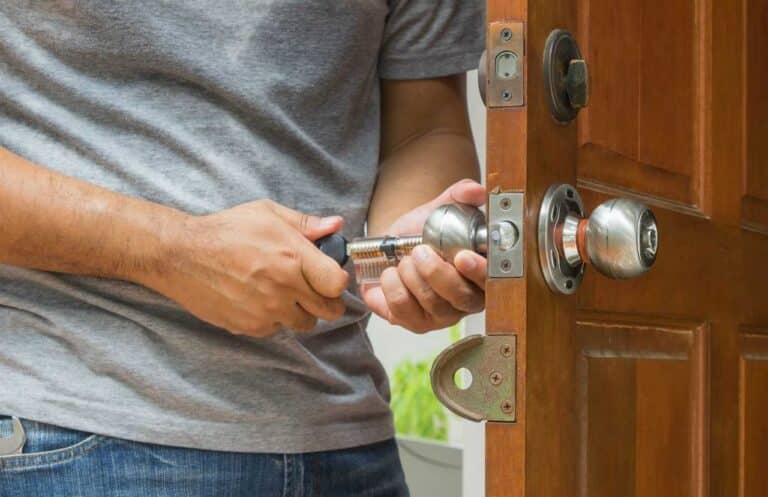Introduction
How To Unjam Door Lock: A jammed door lock can bring an unexpected halt to your daily routine, causing frustration and inconvenience. Whether you’re facing a lock that won’t turn, a key that’s stuck, or a latch that refuses to budge, learning how to effectively unjam a door lock is a skill that can prove invaluable in various situations. From home security to workplace maintenance, understanding the underlying causes of lock jams and knowing how to address them can save you time, money, and unnecessary stress.
A jammed door lock can be an unexpected and frustrating inconvenience, leaving you feeling trapped and uncertain about how to regain access. Whether it’s a sticky key, a misaligned latch, or a worn-out mechanism, knowing how to effectively unjam a interior door lock is a valuable skill that can save you time, money, and potential stress.The secrets to resolving lock jams and restoring the smooth functioning of your doors, one step at a time.
From simple adjustments and lubrication to more advanced maneuvers, we’ll walk you through a variety of methods to unjam different types of locks, including traditional key locks, deadbolts, and modern electronic locks. Moreover, we’ll provide valuable tips on preventive maintenance to keep your locks in optimal condition and reduce the likelihood of future jams.

What lubricant for door locks?
What’s the best lubricant for your lock? When choosing the best product to lubricate locks, dry lubricants like graphite powder and PTFE lubricants are best. As mentioned above, oil-based products can attract dust and dirt which can damage the delicate internal mechanism of your lock.
Fine graphite powder is a dry lubricant. It decreases friction without accumulating dirt and dust, making it ideal for door locks. Interior locks benefit from graphite powder over liquid lubricants.
Silicone Spray: Water-resistant silicone-based lubricants work for indoor and outdoor locks. Long-lasting lubrication and dirt resistance. Silicone sprays are safe on metal and plastic. PTFE (polytetrafluoroethylene) lubricants are heat-resistant and provide excellent lubrication. A durable, non-stick coating reduces friction and wear.
White Lithium Grease: This heavier grease sticks to surfaces and is ideal for heavy-duty locks and wet places. It resists rust and corrosion for years. Door locks can be lubricated with light machine oil or sewing machine oil. Though they penetrate deeply and lubricate well, these oils may collect dust and debris.
Why won’t my key turn in my door?
Your door lock could be frozen if it won’t turn. You can try thawing the door lock with a warm key. Warm the key by placing it in a bowl of hot water and then, with gloves on, dry the key and then insert it slowly into the lock.
Key Misalignment: One of the most common reasons a key won’t turn is misalignment. Over time, or due to rough handling, the keyway and the key itself can become misaligned, preventing the key from fitting properly into the lock.
Worn Key or Lock: Used keys and locks wear out. Worn keys and locks can cause poor engagement and resistance when turning.
Foreign Objects: Dirt, debris, or small foreign objects can find their way into the keyway, obstructing the key’s path and preventing it from turning.
Rust and Corrosion: Exposure to moisture and environmental factors can lead to rust and corrosion within the lock mechanism, inhibiting smooth movement.
Internal Component Issues: Internal components, such as springs or pins, may become damaged or misaligned over time, causing interference with the key’s operation.
Can you use Vaseline to lubricate a door lock?
As with all mechanical objects with moving parts, doors and hinges need to be lubricated on a fairly regular basis. There are a number of products you can use to ensure everything is running smoothly. One of the simplest ways to lubricate your hinges and locks is to use Vaseline.
Vaseline is readily available and typically found in households, making it ideal for rapid cures.
A thin layer of Vaseline can reduce friction and make the key turn more smoothly in the short term.
Vaseline’s water resistance helps preserve the lock from rust and corrosion.
Vaseline is safe and non-toxic, which is comforting when used in pet- and child-friendly locations.
Gummy Residue: Vaseline can collect dust and dirt, generating a sticky, gummy residue that hinders lock performance and attracts more debris.
Inconsistent Performance: Vaseline may only temporarily prevent lock jams and not fix the root cause.
Viscosity: Vaseline is thick, thus overapplication might block the lock’s internal components.
Limited Durability: Vaseline works initially, but it might dry up and lose its lubrication, requiring repeated reapplication.
Should you oil a door lock?
Locks can stiffen up over time as dirt and grime work their way in. If you are finding it harder and harder to turn the key in your lock – and your children are complaining that they can’t do it at all – it may be time to replace the whole mechanism. However, it is always worth trying to lubricate the lock first.
Choose the Right Lubricant: Use graphite powder, silicone spray, or Teflon-based lock lubricants. These products give excellent, long-lasting lubrication without clogging the lock.
Clean the Lock: Remove dirt, debris, and old lubrication residues before applying lubricant. Clean the keyway and interior components with a gentle brush or compressed air. Apply a little lubrication to the key and insert it into the lock. Rotate the key several times to evenly distribute lubrication.
Avoid Over-Oiling: Excess lubrication can attract dust and debris, causing lock difficulties. Remove excess lubricant from the lock’s exterior with a clean cloth after oiling. Prevention of dust buildup ensures cleanliness.
Regular Maintenance: Oil door locks once or twice a year or when the key seems stiff or difficult to turn.
Can I use cooking oil to lubricate door?
If you have a squeaky door or doors, or really if you have doors with hinges that could potentially become annoyingly squeaky in the future, you should grease the hinges with vegetable oil. Add a dab or two of oil to a clean cloth and rub the oiled cloth along the hinge.
Residue Buildup: Cooking oil, especially vegetable oils, can leave behind sticky residues that accumulate dust and debris over time. This buildup can lead to even more friction and potentially worsen the original problem.
Attracting Pests: The residual smell of cooking oil can attract pests, such as insects or rodents, to the treated area, potentially creating additional household challenges.
Lack of Longevity: Cooking oils are not designed for long-term lubrication. They tend to evaporate or break down relatively quickly, leading to the need for frequent reapplication.
Potential Damage: Over time, some cooking oils may become rancid or acidic, potentially causing damage to the surfaces they come into contact with, including the door’s finish.
Inconsistent Performance: Cooking oil may not provide consistent and effective lubrication for doors, leading to unpredictable results and potentially necessitating professional intervention.
Why is key stuck in lock?
Keep cool, follow these guidelines, and you should avoid calling a locksmith! Keys get stuck in locks because the keyhole needs lubrication. Keys collect dust and lint from pockets and bags, which transfers to locks when used.
Misalignment is a major cause of key stuckness. Over time, wear and tear or improper insertion might misalign the key and lock pins, prohibiting smooth functioning.
The lock’s interior components can rust and corrode due to dampness and environmental factors. This causes friction that makes turning the key hard.
Foreign items: Dirt, dirt, and small foreign items can clog the keyway and stall it.
Key or Lock Worn: Keys and locks wear with time. Worn keys and locks can cause poor engagement and key sticking.
Keys might also get stuck due to lock internal issues like worn pins or a broken tumbler.
Try lightly jiggling the key while applying slight pressure to see if it can be moved out of the stuck position.
A lock lubricant like graphite powder or silicone spray can reduce friction and make key turning easier. Insert and gently wiggle the lubricated key to disperse lubricant.
What is the best oil for oiling doors?
If you would prefer to treat your door using an oil, we would recommend either Osmo Door Oil 3060 or Osmo Door Oil 3033. We have carried out independent testing for these products and have seen no adverse effects.
Viscosity: The viscosity, or thickness, of the lubricant is crucial. A lubricant that is too thick may result in excessive buildup or difficulty in application, while one that is too thin might not provide adequate protection.
Longevity: An effective door lubricant should offer long-lasting protection to minimize the need for frequent reapplication.
Residue: The lubricant should not leave behind sticky residues that attract dust and debris, potentially causing more harm than good.
Water Resistance: Doors are exposed to different environmental conditions, so a water-resistant lubricant prevents rust and corrosion.
The lubricant should be compatible with your doors’ metal, wood, or plastic materials.
Graphite Powder: Graphite is a dry lubricant that is highly effective for door locks and hinges. It provides excellent friction reduction without leaving sticky residues, making it a popular choice.
How to unlock a lock without the key?
Hold the tension wrench twisted in the correct direction and insert the rake into the lock where the teeth of the keys would go. Push and pull the rake out of the lock, twisting it and working by feel. Twist the tension wrench in the correct direction, and the lock should spring open!
Lock picking takes practice and precision. To imitate the key’s turning action, use lock picks and tension wrenches to adjust the lock’s internal components. Locksmiths and trained professionals employ this method.
A carefully made bump key is used to control lock pin collisions during lock bumping. This approach can temporarily leap the pins, opening the lock. Bumping needs skill and may damage the lock.
Locksmiths use sophisticated tools to unlock doors without damage. This can be effective and non-destructive if you have locksmith tools and knowledge.
The lock’s keyway is imprinted and manipulated with a blank key to fit the pins and tumblers. The process takes time and skill.
Lock drilling can damage the lock and door, thus it should be a last resort. Drilling the lock’s pins can open the door if everything else fails. This method may require lock replacement.

Conclusion
You’ve tried many approaches to diagnose lock jams and apply specific solutions for distinct lock types and situations. By practicing preventive maintenance, you can avoid lock jams. You make your home and workplace safer and more convenient by applying this new knowledge. A working lock shows your resourcefulness and capacity to handle unexpected events.
Throughout this journey, you’ve delved into the inner workings of stucks locks, unraveling the mysteries behind their malfunctions. You’ve learned to decipher the language of stuck keys, misaligned latches, and stubborn tumblers. Your toolkit of techniques, from gentle nudges to precise adjustments, is a testament to your dexterity and adaptability.
The value of your new knowledge goes beyond the immediate remedy. It’s a sign of self-reliance and your ability to overcome obstacles. Restoring lock control improves security, restores daily life, and takes control of your environment. As you move forward, remember that preventive care is key to success. Maintenance, lubrication, and inspections will help you fight lock jams. These habits will prolong your hair and give you peace of mind.

